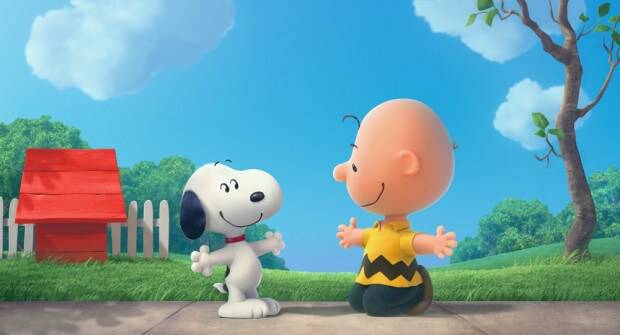Snoopy And Charlie Brown: The Peanuts Movie – Successful CGI Makeover?
How do you take a comic strip – one that ran for fifty years and thrived on the sisyphean struggles of its central character – and translate it into a 90-minute feature film – a storytelling medium that depends upon its hero having a one-off, life-changing experience – without losing the heart of what made that comic strip special?
To make it tougher, the strip in question was the one that reinvented the form for the second half of the twentieth century and set the standard for the minimal style of artwork that would fit neatly into the two-inch-high space that newspaper publishers had decided it was worth. Cinema on the other hand is in an era where style and spectacle is valued over content as never before, and in which one commercial property after another has been dusted off and given a CGI makeover in the hope that a bit of noise and spectacle will drag enough modern kids down to the mulitplex to keep paying the shareholders’ mortgages.
If that’s not enough, it seems the message of every film pitched at kids has to be “follow your dreams, and inevitably you’ll get what you want.” Every hero has his efforts rewarded, and everyone learns that they ARE special after all. The orthodoxy is that this is what we all want to be told, and what we’ll pay to be told.
What place is there in this picture for a hero whose heroic efforts are never rewarded; who, despite his enduring faith in humanity, is always disappointed – whose football is always pulled away?
I can imagine these questions and others being bounced around meeting rooms for months or years while this film was in development, and what shines through in The Peanuts Movie is the determination of everyone involved to find the best possible answer. There are moments when I almost felt like the circle was struggling to be squared, but they are few and far between. The battle is decisively won.
Unlike most of the half-hour specials, the story is not based directly on a narrative from the strip itself, but is assembled largely from elements of it, and regular features are neatly woven in, such as Lucy’s psychiatry booth and Charlie Brown’s heroic perseverance in trying to fly a kite.
In a nutshell, a new kid arrives in the neighbourhood – a little red-haired girl, of course – and captures Charlie Brown’s heart. After a five-cent consultation with Lucy, he feels he has to prove to her that he is not a loser, but a winner worthy of her affections. Charlie Brown being Charlie Brown, this doesn’t go as planned.
I think they’ve succeeded remarkably well in translating Schulz’s simple squiggles into state-of-the-art CGI. There is still a hand-drawn feel to the way the facial features in particular are rendered, and the characters have a pleasingly tactile quality. There are even some genuine hand-drawn sequences that capture the strip with great accuracy – better in fact than the Melendez cartoons did.
Much care has been taken to ensure the characters themselves remain faithful to their originals. Snoopy is particularly successful in that he follows his own narrative, only participating in the main drama as long as it dovetails with his own fantasy world. He may be Charlie Brown’s best friend but it’s not going to stop him getting the Red Baron. Speaking of which, it was clearly felt that there was a need for action and spectacle, and in contrast to the comic strip there is no shortage of this, but most of it takes place in Snoopy’s imagination. We never saw this in the comic the way we did in, say, Calvin and Hobbes, so to that extent it’s a departure, but it does succeed quite well in translating what went on in his thought bubbles by cutting between his fantasy world and the real one. There are action-filled sequences in the real world too but they never dominate the story, and are punctuated by visual gags that are not too in-your-face but neatly match the underlying warmth.
Finally – and I’ll try not to give too much away here – how to give a Peanuts feature film an ending that is faithful to its source material but doesn’t send its audience away on a downer?
In 1969’s “A Boy Named Charlie Brown”, our hero competes in a big spelling bee – that odd American tradition where kids have to stand up in front of an audience and spell out loud words that are read out to them – but blows the contest at the final and once again goes home the loser. However a comforting talk from the ever-wise Linus reassures him that this isn’t as bad as he imagines. The world didn’t come to an end, and tomorrow everyone will have forgotten about it and moved on, as he should. It’s a sad truth of life that we can’t all be winners – at least not with any regularity. We love Charlie Brown because he reminds us that the experience is universal, and we have to plod on regardless. It’s a comforting ending, but not one likely to send an audience out with a spring in their step.
The ending of The Peanuts Movie is, I think, a qualified success. It lets us go away a little more cheerful, and arguably does so at the expense of total faithfulness to the comic strip, but it does allow Charlie Brown to remain Charlie Brown, while communicating something perhaps a little nobler than ‘follow your dreams’.
And there’s still that football.



